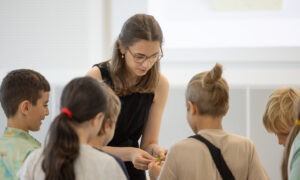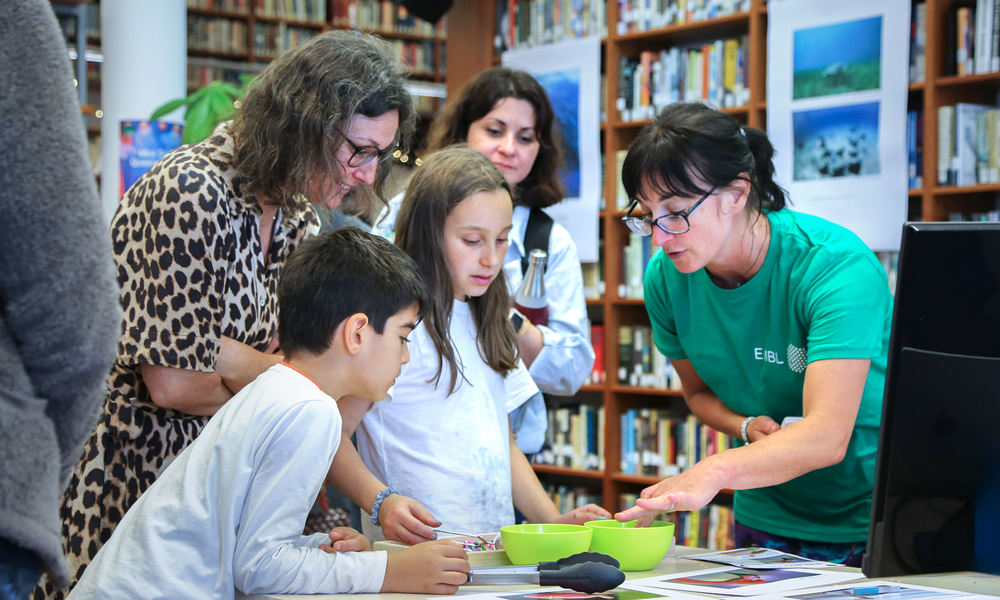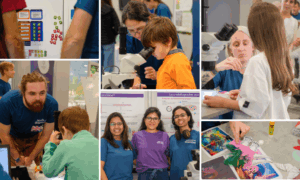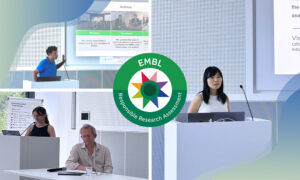
Every drop counts: a dive into Oceans Day
On this Oceans Day, EMBL’s Science Education and Public Engagement (SEPE) Team joined forces with the German-American Institute (DAI) to bring the underwater world closer to families in Heidelberg

By Pavlina Markova, Predoctoral Fellow, Watt Group
‘The Blue Planet’ – the nickname stems from one of Earth’s most iconic traits – having 71% of its surface covered by oceans. Oceans are vital for regulating the climate, sheltering an astonishing diversity of plants and animals, and providing us with food and resources. For over 30 years, their importance has been celebrated annually on 8 June as World Oceans Day. This has also served as an opportunity to increase awareness about the oceans and inspire action to ensure their protection.
This year, EMBL’s Science Education and Public Engagement (SEPE) Team joined forces with the German-American Institute (DAI) Heidelberg to bring the underwater world closer to families in Heidelberg, interlinking hands-on discovery activities with creative workshops and art stations. The event was warmly received by the public and was attended by around 125 participants.
The afternoon kicked off with a session designed for the youngest attendees, featuring ocean-themed stories and cuddly toys to spark curiosity and foster a love for the ocean. A variety of activity stations were set up for older participants.
Children had the chance to explore the hidden life within water samples by observing microplankton under a microscope, crafting their own plankton-shaped clay fridge magnets, and competing in a lively game of plankton bingo. To experience the impact of plastic pollution firsthand, children tried to separate grains of rice from small plastic beads, mimicking how birds forage and the difficulties they face. To achieve this, children used tools of various sizes to simulate the beaks of different bird species — chopsticks for gulls, tweezers for sandpipers, spoons for spoonbills, and a tea strainer for flamingos. In addition, volunteers showcased EMBL’s scientific and sustainability efforts to combat plastic waste, including the MGnify database, which helps identify enzymes capable of breaking down plastic.
To convey the vast scale and interconnectedness of the ocean – and the lasting impact of what enters it – participants learned about the 1992 rubber duck spill. Using a map, they estimated how far the ducks had travelled, illustrating how ocean currents can carry objects across great distances. This activity also introduced the concept of the global conveyor belt, a system of ocean currents that circulates water around the planet.
Through art, children had the chance to immerse themselves in an underwater experience by lying on the sandy ocean floor and painting what they imagined above – shimmering water and the silhouettes of sea creatures – using a variety of techniques, including acrylics, watercolours, and pastels.
The event also showcased a self-made video from the DAI Creative Kids group, depicting underwater creatures and their struggle against pollution, highlighting the urgent need to protect and preserve the oceans. The stage was also given to two young speakers from the Public Speaking group, who shared their personal experiences of living near the ocean, their perspectives on the threats it faces, and our shared responsibility to safeguard it. An interactive, ocean-themed quiz engaged participants with small prizes.
To conclude the event, Flora Vincent, Group Leader at EMBL Heidelberg and recipient of the 2025 Planet Earth Award from the Alliance of World Scientists, delivered a talk. “What do you see?” asked Vincent, showing an image of sharks gliding through the water to her captivated audience. When silence followed, she reassured them with a smile, “It’s not a trick question.” “Sharks,” came a shy reply from within the library. Vincent nodded in agreement, admitting that she too once pictured the ocean in such terms. Today, however, she’s drawn not to the fish, but to the blue pixels around, containing the microbes that quietly shape our climate.
Vincent spoke about her fascination with plankton, a vast community of organisms invisible to the naked eye that drift with ocean currents, forming the foundation of marine ecosystems. Vincent emphasised the crucial role of the ocean and plankton in sustaining our planet. “If the Amazon is one lung of the Earth, the ocean is the other,” she said. Yet, despite their critical role, she pointed out how little we know about the marine world, noting that “more people have walked on the Moon than on the bottom of the ocean” – even though the latter is 35,000 times closer.
Vincent shared her personal experience aboard a Tara Oceans’ expedition dedicated to an unprecedented mission: the worldwide study of marine plankton. This initiative inspired numerous others, including EMBL’s recent Traversing European Coastlines (TREC) project. She also explained how data from such missions allow scientists to explore both the past – such as investigating the origin of mitochondria, the cell’s powerhouses – and the future, e.g. helping predict how climate change may reshape ocean ecosystems.
On this Oceans Day, her words serve as a powerful reminder of how deeply our lives are intertwined with the ocean, and just how essential it is to raise awareness and safeguard its future.


